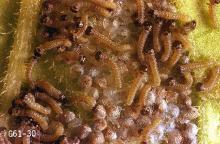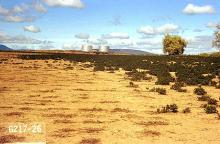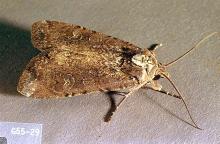Includes
Army cutworm (Euxoa auxiliaris)-adults are called "miller moths"
Clover cutworm (Anarta trifolii)
Dingy cutworm (Feltia jaculifera)
Granulate cutworm (Feltia subterranea)
Redbacked cutworm (Euxoa ochrogaster)
Variegated cutworm (Peridroma saucia)
Pest description and crop damage Cutworms usually are dull gray, brown, or black and may be striped or spotted. They often curl up when disturbed. They usually feed at night and by day are found under leaves or in the soil at moisture level. Cutworms can kill seedlings and reduce stands. If alfalfa fields do not "green up" in the spring, or are slow to regrow after cutting in the fall, look for cutworms. Small populations (less than one larva/sq yd) can damage new seedlings. Cutworms are primarily a pest of alfalfa and clovers, but they attack other legumes also. Army cutworms, redbacked and variegated cutworms begin feeding in the fall and overwinter as half-grown larvae in grain and hay fields. Most damage occurs as caterpillars complete their development in spring. In mild winter years, be aware of large populations that can cause significant damage in late winter and early spring. In mild winter years, be aware of large populations that can cause significant damage in late winter and early spring. Variegated cutworm has an overwinter generation similar to the army cutworm and a midsummer generation. Redbacked cutworms overwinter as eggs and caterpillars commence feeding in late winter to early spring.
For additional information, see: https://ipm.ucanr.edu/agriculture/alfalfa/cutworms/#gsc.tab=0.
Management-chemical control
When convenient, irrigate the field before treating for redbacked or army cutworms. This brings larvae to the surface, making control easier. Applications in late evening, when larvae usually feed above ground, are most effective.
- alpha-cypermethrin (Fastac EC) at 0.014 to 0.025 lb ai/A. PHI 3 days of cutting or grazing. REI 12 hr. Retreatment interval 7 days. Do not exceed 0.025 lb ai/cutting and 0.075 lb ai/A per season. This product is highly toxic to bees exposed to direct treatment or residues on blooming crops or weeds. Do not apply this product or allow it to drift to blooming crops if bees are visiting the treatment area. (Group 3A)
- azadirachtin (Aza-Direct, Neemix 4.5)-See specific labels for rates. PHI 0 days. REI 4 hr. Aza-direct and Neemix 4.5 are OMRI-listed for organic use.
- Bacillus thuringiensis (numerous products) at 0.25 to 1.5 lb product/A. PHI 0 days. REI 4 hr. Most effective on small caterpillars; use highest recommended rate for more mature caterpillars. Evening applications increase efficacy. A spreader-sticker may improve performance. Some formulations are OMRI-listed for organic use. (Group 11)
- beta-cyfluthrin (Baythroid XL) at 0.0065 to 0.0125 lb ai/A. PHI 7 days for grazing or cutting. REI 12 hr. Do not exceed 0.044 lb ai/A per cutting or 0.175 lb ai/A total per season. Retreatment interval 5 days. This product is highly toxic to bees exposed to direct treatment or residues on blooming crops or weeds. Do not apply this product or allow it to drift to blooming crops if bees are visiting the treatment area. (Group 3A)
- carbaryl (numerous products) at 1 to 1.5 lb ai/A. PHI 7 days for grazing or cutting. REI 12 hr. Do not apply more than once per cutting. Carbaryl may burn or yellow hay under some conditions (wet foliage, high humidity). Latex-based formulations, such as Sevin XLR Plus, are less hazardous to bees. (Group 1A)
- chlorantraniliprole/lambda-cyhalothrin (Besiege) at 0.049 to 0.078 lb ai/A. PHI 1 day for forage and 7 days for hay. REI 24 hr. Minimum of 5 days between applications. Do not exceed 0.12 lb ai of lambda-cyhalothrin or 0.2 lb ai of chlorantraniliprole-containing foliar products per acre per growing season. Refer to product labels for application limits if products containing gamma-cyhalothrin and products containing lambda-cyhalothrin are to be used in the same season. This product is highly toxic to bees exposed to direct treatment or residues on blooming crops or weeds. Do not apply this product or allow it to drift to blooming crops if bees are visiting the treatment area. (Groups 28 and 3A)
- Chromobacterium subtsugae (Grandevo) at 0.3 to 0.9 lb ai/A per 100 gal. PHI 0 days. REI 4 hr. OMRI-listed for organic use. (Unidentified Mode of Action group)
- cyfluthrin (Tombstone) at 0.013 to 0.025 lb ai/A. PHI 7 days for grazing or cutting. REI 12 hr. Retreatment interval 5 days. Do not exceed 0.088 lb ai/A per cutting or 0.35 lb ai/A total per season. This product is highly toxic to bees exposed to direct treatment or residues on blooming crops or weeds. Do not apply this product or allow it to drift to blooming crops if bees are visiting the treatment area. (Group 3A)
- gamma-cyhalothrin (Declare) at 0.0075 to 0.0125 lb ai/A. PHI 1 day for forage harvest or 7 days for hay harvest. REI 24 hr. Do not exceed 0.015 lb ai/A per cutting or 0.06 lb ai/A per season. Refer to product labels for application limits if products containing gamma-cyhalothrin and products containing lambda-cyhalothrin are to be used in the same season. This product is highly toxic to bees exposed to direct treatment or residues on blooming crops or weeds. Do not apply this product or allow it to drift to blooming crops if bees are visiting the treatment area. (Group 3A)
- indoxacarb (Steward) at 0.065 to 0.11 lb ai/A. PHI 7 days for grazing or cutting. REI 12 hr. Do not exceed one application per cutting or 0.44 lb ai/A per season. This product is highly toxic to bees exposed to direct treatment or residues on blooming crops or weeds. Do not apply this product or allow it to drift to blooming crops if bees are visiting the treatment area. (Group 22A)
- lambda-cyhalothrin (Warrior II) at 0.015 to 0.025 lb ai/A. PHI 1 day for forage harvest or 7 days for hay harvest. REI 24 hr. Apply only to pure stands. Do not apply when bees are actively foraging. Do not exceed 0.03 lb ai/A per cutting or 0.12 lb ai/A per season. Refer to product labels for application limits if products containing gamma-cyhalothrin and products containing lambda-cyhalothrin are to be used in the same season. This product is highly toxic to bees exposed to direct treatment or residues on blooming crops or weeds. Do not apply this product or allow it to drift to blooming crops if bees are visiting the treatment area. (Group 3A)
- methomyl (Lannate LV; other products) at 0.23 to 0.9 lb ai/A. PHI 7 days for grazing or cutting. REI 48 hr. Do not exceed 10 applications or more than 3.6 lb ai/A per season. This product is highly toxic to bees exposed to direct treatment or residues on blooming crops or weeds. Do not apply this product or allow it to drift to blooming crops if bees are visiting the treatment area. (Group 1A)
- permethrin (numerous products) at 0.05 to 0.2 lb ai/A. PHI 0 days at 0.1 lb ai/A or less, 14 days at more than 0.1 lb ai/A. REI 12 hr. Do not exceed 0.2 lb ai/A per cutting. Retreatment interval 30 days. Permethrin is highly toxic to bees exposed to direct treatment or residues on blooming crops or weeds. Do not apply this product or allow it to drift to blooming crops if bees are visiting the treatment area. (Group 3A)
- spinosad (Entrust SC) at 0.031 to 0.063 lb ai/A. PHI 0 days forage; 3 days hay or fodder. REI 4 hr. Only for suppression of alfalfa weevil larvae. Do not exceed 0.186 lb ai/A per season. Do not exceed 6 applications per season. This product is toxic to bees exposed to treatment for 3 hours following treatment. Do not apply this pesticide to blooming, pollen-shedding or nectar-producing parts of plants if bees may forage on the plants during this time period. Some formulations are OMRI-listed for organic use. (Group 5)
- zeta-cypermethrin at 0.028 to 0.05 lb ai/A (Mustang), or at 0.014 to 0.025 lb ai/A (Mustang Maxx). PHI 3 days for cutting or grazing, 7 days for harvesting seed. REI 12 hr. Retreatment interval 7 days. Do not use more than 0.1 lb ai/A per cutting or more than 0.3 lb ai/A per season (Mustang) or 0.05 lb ai/A per cutting or 0.15 lb ai/A per season (Mustang Maxx). These products are highly toxic to bees exposed to direct treatment or residues on blooming crops or weeds. Do not apply this product or allow it to drift to blooming crops if bees are visiting the treatment area. (Group 3A)







